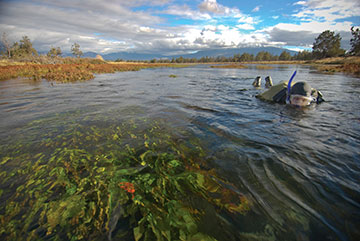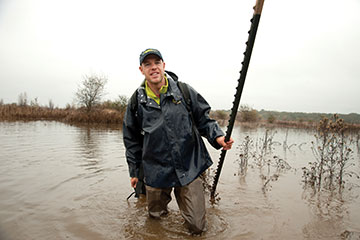Volume 31 · Number 2 · Spring 2014
A watershed momentum

Carson Jeffres snorkels Shasta River to evaluate efforts by The Nature Conservancy to improve runs of endangered coho salmon in Northern California.
(Bridget Besaw for The Nature Conservancy)
The cramped field researchers’ office carries the faint whiffs of fish, locker room and dog. Louie, the Labrador, snoozes on his tattered mattress under a desk alongside mud-caked wading and hiking boots, a wet bag, dusty backpack and the big sandaled feet of his owner, Carson Jeffres.
Jeffres ’02, M.S. ’06, parks at his computer monitors back-to-back with Ryan Peek and parallel with Drew Nichols, M.S. ’08. No privacy panels separate the three cozy researchers. The fish biologist, amphibian ecologist and geologist are here to collaborate. The same goes for the entomologists down the hall and the economists, hydrologists and engineers around the corner.
They’re all part of an environmental research hub at UC Davis known as the Center for Watershed Sciences, a name that reflects its holistic view of rivers, lakes and estuaries.
“If it’s part of a watershed, we study it,” said Jeffres, speaking unscripted for a recent documentary about the center, which is aptly located near the Arboretum Waterway at La Rue Road and California Avenue.
Center to lead
UC Drought Summit
With California in a major drought, Chancellor Linda P. B. Katehi has tapped the Center for Watershed Sciences to organize and lead a UC Drought Summit on April 25 at the state Capitol.
Many universities recognize the value of multidisciplinary research programs, particularly for investigation of environmental problems — examining how everything is connected to everything else. But organizational walls can thwart needed integration.
At UC Davis, some prominent professors found a way. Beginning in 1998, they built the research center across several colleges, departments and disciplines to better understand and solve California’s complex and contentious water issues.
After 16 years, the Center for Watershed Sciences is California’s leading academic institute on water management, providing scientific insights for policymakers wrestling with issues critical to California’s health and prosperity. The center’s work influences and informs legislation, policy and management concerning water supply, drinking water safety, flood control, agricultural production, hydroelectric power, recreation, and the survival of salmon and other native fish species.
The university recently received an emphatic endorsement of this academic engagement with a $10 million donation to the center. The gift from S.D. Bechtel, Jr. Foundation of San Francisco will enable the center to expand its scientific research and public engagement capabilities as the climate warms and water demands increase, said Jay Lund, the center’s director and a professor of civil and environmental engineering.
Jeffres, 35, is one of the rising leaders in the center, which draws dozens of researchers, faculty members and students from many departments to work with experts from across the West and internationally.
“He was one of our first hires [in 1999], one of those who showed that you could have fun and do research and be very productive in the process,” said Jeffrey Mount, a professor emeritus of geology and whitewater rafting enthusiast who co-founded the center with Peter Moyle, a professor of fish biology who continues to serve as associate director.
Tall and as sleek as his racing bicycle, Jeffres — as with many of his colleagues at the center — found a wonderful blending of avocation with vocation.
“I’m a fish biologist by trade, but, even when I’m not at work, I spend most of my time playing on rivers kayaking and fishing. I have inherent interest in what happens in my local watersheds. I want my kids to have the opportunity to use the same resources that I’ve used,” said Jeffres, who became a father in November.
The key to preserving those opportunities, Jeffres said, “is finding creative solutions to deal with the competing needs of environmental water uses and human water needs.”

Carson Jeffres sets nets to trap fish for measurement and identification. The center’s field and lab director and colleagues are studying how fish are using a restored floodplain in the Cosumnes River Preserve south of Sacramento.
(Gregory Urquiaga/UC Davis)
State officials have long relied on computer models developed at the center for those solutions to assess potential effects of proposed policies. “There are rules and laws about how water moves and what it’s worth, and we can represent that technically,” said Lund, who with graduate students developed California’s only statewide, integrated water supply model.
One finding from the model showed that the San Francisco Bay Area could continue receiving high-quality Tuolumne River water without Hetch Hetchy reservoir, albeit at a high cost. That 2003 study by Lund’s then-graduate student Sarah Null, inspired The Sacramento Bee’s 2004 Pulitzer-prize winning series of editorials on reclaiming Hetch Hetchy Valley, Yosemite Valley’s underwater twin.
The Hetch Hetchy study speaks to the center’s core mission of improving public understanding and discussion of California complex water issues, which are often mired by myths and controversies.
Mount delivered a wakeup call in 2005, shortly after Hurricane Katrina. He and another UC scientist, Robert Twiss, published a study concluding that over the next 50 years, there is a two-in-three chance that a major storm or earthquake will cause widespread levee failure in the Sacramento-San Joaquin Delta, a drinking water source for more than 25 million Californians.
More recently, Moyle and his team of fish biologists reported that as many as 82 percent of 121 native fish species are likely to be gone in 100 years as climate change accelerates declines of already depleted populations.
Some of the center’s most influential contributions have focused on the Delta, the heart of the state’s water delivery system and a perpetual battleground for competing agricultural, urban and environmental water interests. Phil Isenberg, chair of the state’s Delta Stewardship Council, applauds the center for even entering the water policymaking arena, notorious for its caustic exchanges.
“Doing research that is expected to be useful to policymakers is a pretty daring thing for scientists to do,” Isenberg said. “It requires them to talk to people who don’t speak the same language, who don’t have the same time frame and who are motivated by a host of factors — science being only one of them. You have to scratch your head hard to find success stories.”
One of those success stories is the center’s collaboration with the Public Policy Institute of California (PPIC) on two reports presenting policy options for managing the Delta — including some form of a peripheral canal that would tap water further upstream to reduce environmental harm in the estuary.
The reports were pivotal in shaping the state’s historic Delta Reform Act of 2009, which reorganized state management of the Delta. “Being perceived as not having a particular dog in the fight was key,” said co-author Ellen Hanak, an economist and senior fellow with the PPIC.
So, too, was the center’s trademark multidisciplinary approach. The Delta project brought together five faculty, 10 researchers and 28 students from four colleges on campus.
They all share Jeffres’ approach to complex water problems: “When you go to look for solutions in a watershed you have to have a team that’s diverse if you want real solutions.”
